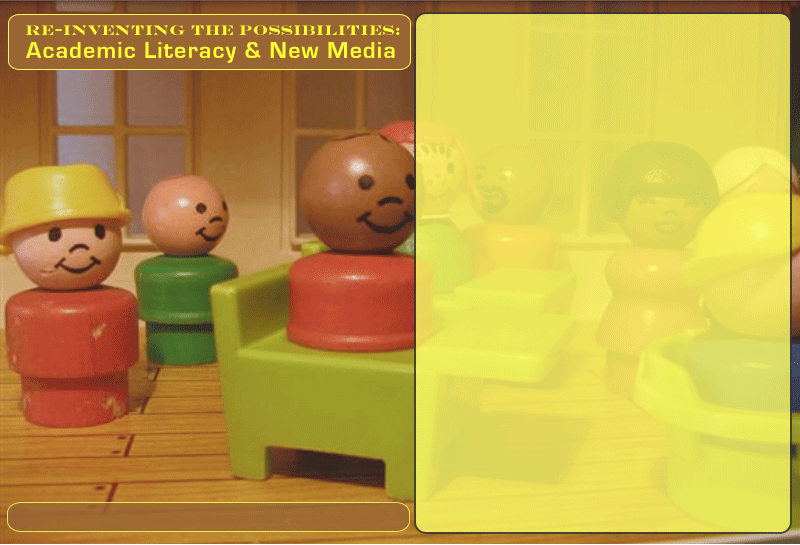
Curtis' example, seen here, calls specific attention to its materiality and invites a reader to negotiate meaning amongst the various elements in the text. It is composed of several smaller elements, including photos that are juxtaposed with words and phrases. The words in blue indicate modes, or the vehicles of mobility. For example, the element 'perspective' juxtaposes three photos that depict various people utilizing different modes of transportation and locomotion from bikes and skateboards to sidewalks and footpaths. Each particular modality gives a traveler a different perspective on the world and the people around him or her. The smaller words in maroon indicate nodes, or the intersection of modes and modalities. Words like hallway, campus, and enter indicate spaces between classrooms, intersections of modes of transportation, and the difference between inside and outside.
The piece has an overall linear sequence, which moves chronologically from top to bottom and left to right. This is represented by the node 'drive to school' at the top left, which indicates the beginning of Curtis' map, and by 'go home' at the bottom right, or the end of the journey. Yet, there are elements that resist such a linear reading of the text. For example, the sequence of 'society-world-perspective-people-vehicle' elements causes me to read around the text, rather than through it, and to skip some elements altogether. Additionally, the element 'people' straddles two images, which are close in proximity but not in sequence. Such juxtaposition resists a reading that looks at each image in order for one that investigates the relationships between overlapping elements.
Another strategy that resists a chronological reading is the repetition of full color photographs throughout the text. These images, which usually include Curtis' feet, serve to demonstrate the speed and perspective from which Curtis observes his surroundings. But they also serve to orient the reader in the space of the text. Much like a compass or an indicator of north, these images remind us that this is a map as well as a travelogue. Additionally, the full-color image upon which the word time is written at the bottom center of the collage makes me think of a sundial, which tells the time based upon the movement of the sun rather than the passage of seconds, minutes, and hours. This element, without reference to a clock or watch, demonstrates the passage of time through the text, through the designer's day, and through his movement through space. Time is more than just minutes; it is about space, place, and relativity. These full-color photographs are what Wysocki refers to as being the materiality of the text, the self-referential elements that convey meaning while demonstrating how the text is produced and of what.
Through proximity and sequence, Curtis makes certain interpretations fairly simple. For example, we know he is a writing center consultant because of his placement of an image of the writing center bulletin board (next to the image of a writing center consultation room) displaying the words 'tutoring: 57 min' at the bottom. However, because the chairs are empty, we have little idea to whom he talked or what he talked about during those 57 minutes. And why 57 minutes and not an hour? These elements, left intentionally open to negotiation, invite a reader to provide meaning. They remind us that any record of a journey is subjective. Anthony Hoete discusses Walter Benjamin's essay, 'The Storyteller,' pointing out that any retelling of an event invites interpretation:
Benjamin crucially depicts any travel record as open to interpretation: the travelogue rests on the selective recounting of distant events rather than their explanation. Loaded with the pretense of factual documentary, the log of a journey will always, in part, be a landscape of fabrication and evocation. The map is by no means an accurate account; it is coloured by the aspirations and perspective of the cartographer. (Hoete, 2003: 26)
In Curtis' text, we see the world through the lens of his camera, and through his choice of elements, sequence, juxtaposition, and color-coding. But there is more to this text that invites a reader to participate in the negotiation of meaning through a careful balance between detail and a lack of contextual features, while utilizing juxtaposition and proximity to provide example, but not explanation.
Go back to the last node.